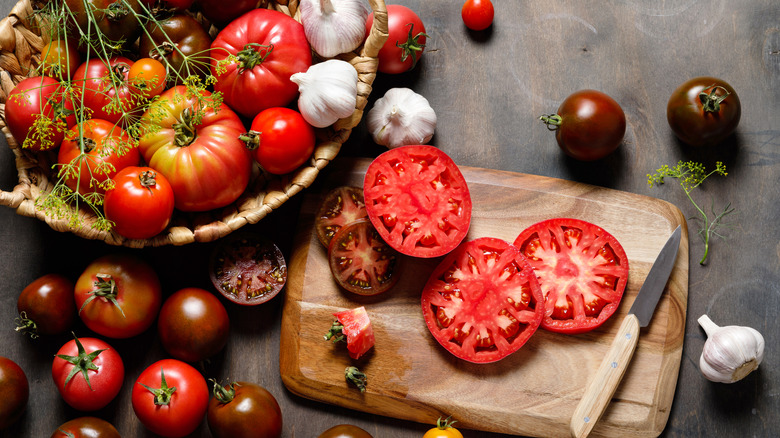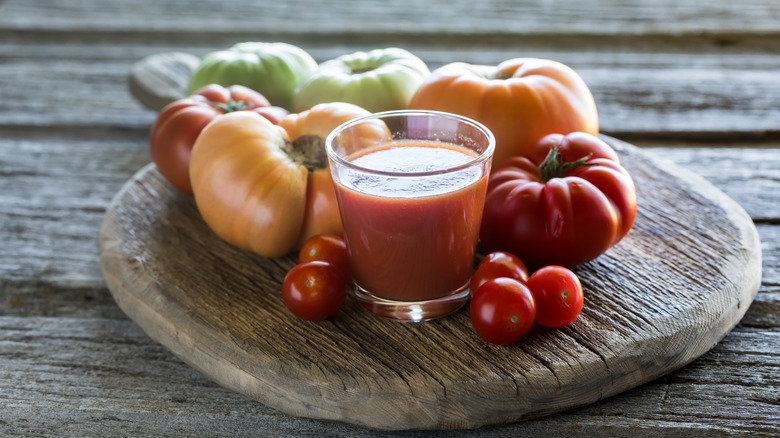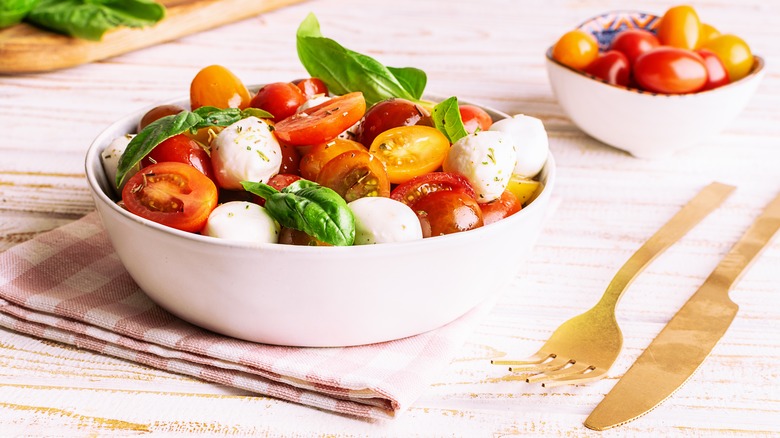The Juice From Your Heirloom Tomatoes Deserves To Be Used
Dicing tomatoes is a process that nearly always results in a cutting board covered in tomato juice. In particular, the heirloom tomato is one of the juiciest, bursting with moist, bright flavor. It seems a shame to let all that excess juice go to waste, but it's too thin and watery to serve as a sauce. Fortunately, what makes heirloom tomatoes so good is that they pack a lot of flavor, meaning their juice will be tastier than most and more worthy of being used as an ingredient in its own right.
While the watery consistency of the juice from heirloom tomatoes may be too thin for many recipes, its liquid medium makes it an excellent candidate for a basic but refreshing vinaigrette. Tomatoes and their juice tend to be naturally acidic, with a pH of around four. That makes it a great addition to a vinaigrette, which tends to be acidic on account of its vinegar content.
How to use juice from tomatoes in your vinaigrette
To make heirloom tomato vinaigrette, you'll first need to make sure those juices don't go to waste. Consider using a cutting board with an elevated border or a juice groove to save the liquid. You can also squeeze out the tomato juice as you would a lemon before dicing the rest of the tomato. Afterward, strain the juice to get out any tomato seeds. For a cup of vinaigrette, you'll want to collect approximately ½ cup of juice, which should be about a few tomatoes worth. Finally, simply combine the tomato juice with a half cup of olive oil along with two tablespoons of vinegar and Dijon mustard, then whisk until thickened to combine.
While heirloom tomatoes' sweetness makes for an excellent vinaigrette, there are a host of other tomato varieties worth trying. A seedless option such as Oregon Star makes for an easy vinaigrette inclusion since you don't have to strain out the seeds. Other sweet varieties like grape and cherry tomatoes also work well. When it comes to the dressing's vinegar component, the sweetness and flavor of red wine vinegar make it a reliable option for both dressings and a tomato pairing, though white wine, sherry, and apple cider vinegar are also good options.
Which salads should you add tomato vinaigrette to?
Any salad that incorporates tomatoes already pairs well with its flavor and allows you to make use of both the tomatoes and vinaigrette in your salad. Using this vinaigrette in caprese salad, for instance, is a solid option, as tomatoes pair well with mozzarella and basil. Tomatoes also work great with numerous fruits like berries and stone fruits along with cured meats, making tomato vinaigrette a good dressing for a prosciutto and peach salad or an earthy strawberry and basil salad.
Tomato vinaigrette also makes for a delightful corn salad, which shines with the sweetness and acid provided by the vinaigrette. Since tomatoes are an excellent salsa addition, it's no surprise that tomato vinaigrette is perfect for a Mexican-inspired salad with corn, peppers, avocados, cilantro, and cheese. Classic Greek salads are a good match for tomato vinaigrette as well, as its components (cucumbers, feta, and peppers) work excellently with a tomato pairing. Tomatoes are an incredibly versatile fruit, and its juice is no exception. So the next time you're dicing tomatoes, be sure to save the juice for a vinaigrette worth making on repeat.


